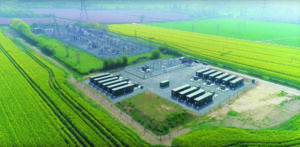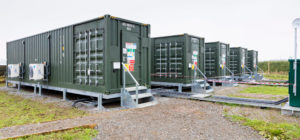
Andy Lowe, Head of Business Development at Flexitricity discusses the emerging battery storage opportunity as the UK transitions towards a low-carbon economy. As the development and investor sector is challenged with transitioning the previously heavily subsidised industry into one that is subsidy free, the demand response expert believes there is potential in the fast-growing market space and early movers might have an edge over their competitors.
Renewables’ march to victory can’t happen without increased flexibility in our energy system, which means that battery storage alongside demand response will play a pivotal role in our transition to a low-carbon economy. National Grid predicts that as much as 30GW of installed battery capacity could be required by 2050. The future looks very bright indeed for battery developers and investors, but the road to there is not free of twists and turns.
I started working in the low carbon energy sector twelve years ago, cutting my teeth on large-scale wind energy. Within a couple of years, I was turning my attention toward smaller-scale renewable projects, as both an advisor and a developer. I worked on projects around GB which were to be incentivised by a new Government scheme: the Feed-in Tariff (FiT). For anyone who was at the FiT theme park during the nine years that the scheme was open, it’s fair to say that FiTs were a bit of a rollercoaster. But boy did FiTs hit the objective of stimulating investment. They provided index-linked payments for 20 to 25 years based on what became pretty accurate yield forecasting, all at a time when equipment suppliers were competing on price. Investor confidence was high and finance for the right projects was readily available.
Now in 2019, the development and investment sector is challenged with the task of transitioning this previously heavily subsidised industry into one that can stand on its own two feet, subsidy-free. When I first entered the world of battery storage as a developer, it became apparent that it was going to be a complex business case. At the time, de-rating factors for storage in the Capacity Market (CM) had been reduced, triad export benefits were for the chop and frequency service prices were starting to drift downwards. Each business case lasted a few months before needing a tweak. And the term “merchant” operation was being floated more frequently into such discussions.
While I understood the basics of this, I knew there was more to learn. I approached Flexitricity for help and within months I was working for them. I now understand the business case and sit on the other side of the desk, spending most of my time assisting developers and investors in getting to grips with these realities. And, make no mistake, it is a hard business case to get your head around.
 Broadly speaking, front of the meter batteries can participate in the CM, Firm Frequency Response (FFR), Fast Reserve and DSO services, and can be traded in the power markets. Added to this, these energy storage assets can be traded directly with National Grid in the Balancing Mechanism. The same asset can contract for all of these services, although apart from the CM the services can’t be delivered simultaneously. Added to this there may be embedded benefits driving particular strategies for assets, and a dollop of triad management in the mix in some geographical areas. Of course, that’s just until the services change. Behind the meter and co-located batteries have slightly differing revenue stacks but similar strategies, market forces and operational governance apply.
Broadly speaking, front of the meter batteries can participate in the CM, Firm Frequency Response (FFR), Fast Reserve and DSO services, and can be traded in the power markets. Added to this, these energy storage assets can be traded directly with National Grid in the Balancing Mechanism. The same asset can contract for all of these services, although apart from the CM the services can’t be delivered simultaneously. Added to this there may be embedded benefits driving particular strategies for assets, and a dollop of triad management in the mix in some geographical areas. Of course, that’s just until the services change. Behind the meter and co-located batteries have slightly differing revenue stacks but similar strategies, market forces and operational governance apply.
Whilst some investors have jumped in, some have dipped their toe and some are waiting to see if those who have jumped come up for air, questions from the investor community are broadly similar:
- What is the best service delivery/operational stack?
An asset owner needs to be able to access all potential revenue streams with the same asset. Remaining solely in ancillary services or solely in the Balancing Mechanism is not optimising the potential of battery storage. In current markets, for a site without any significant geographical benefits, I think the best stack is part FFR (whilst the price holds), taking what is available from the day ahead market but not selling yourself short, refining your position intraday and being available to National Grid in the Balancing Mechanism for the remainder of the time. Embedded benefits will drive pricing strategies and will impact the volumes secured in different markets; investor risk appetite does the same thing. The trick to successful optimisation is to be dynamic and have the right humans and algorithms that enable you to be agile and follow the money.
- How secure is the revenue?
Decent floor price structures might emerge, but until they do no-one should ever say that revenue is secure. Everything you do will be either tendered competitively in the market or traded regularly, right down to individual settlement periods. Whilst some ancillary services can be tendered month ahead, and you can still lock in some term for certain EFA blocks at certain times of the year, values here are likely to be a low percentage of your total stack. This is merchant operation in the energy markets and the risk is yours. The Capacity Market will bring a level of revenue security if/when it is reinstated but as we’ve seen often in the past, requirements and opportunities can quickly change.
-

Anesco’s Clayhill solar farm and energy storage facility, near Flitwick, Bedfordshire Who can do all of this for me?
That one’s easy… Flexitricity offers full access to all revenue streams coupled with market-leading expertise.
The reality is that battery storage is complex for developers and investors previously accustomed to a subsidised environment. It is not simple to understand, and given the appetite for risk and the corresponding hurdle rates that these drive, it is fair to say that there is a reasonable amount stacked against the rapid growth that most want to see in this space. However, if the parties can get their heads around this and are confident about the current and future need for energy storage, then with the right diligence on CAPEX and OPEX, it is a commercial proposal that can be made to work. The key to making it happen is to build a realistic business case and pick the right market access partner.
The final question then remains – should you invest? We believe that the merchant model will be proven soon and we are hard at work – literally 24/7 – to make it happen. Positive regulatory changes are afoot via Ofgem and other bodies, and the demand for flexibility is predicted to grow exponentially. So, for those who can stomach a level of uncertainty, getting an energy storage project off the ground now might indeed be a smart move, landing you in pole position as the market continues to grow.



